#flemish region
Text

Mechelen City Hall, Mechelen, Belgium: Mechelen town hall on the Grote Markt consists of two parts: the cloth hall with unfinished belfry and the Palace of the Great Council. The cloth trade went into decline in the 14th century and there wasn't the money to complete the building. For two hundred years the belfry was no more than a shell, until it was eventually provided with a temporary roof in the 16th century. Wikipedia
69 notes
·
View notes
Text

G H E N T
96 notes
·
View notes
Text
Fallen leaves in Bruges, Belgium

0 notes
Text
Fallen leaves in Bruges, Belgium

0 notes
Text
autumn court inspired by germanic folklore & fairytales, my beloved
#the autumn court in general owns my heart. everyone else is in a romance novel & they're in game of thrones.#the temptation to develop the entire court and its regions.#imagine lesser fae based on the waldleute & changelings (both very fitting for autumn)#feldgeister hidden in the rows of corn. the bergmönch in the mountains. yule witches in their huts.#wolpetingers rustling in the trees. eris' 12 helhonds.#the lorelei singing atop the rocks by the sea.#gothic bavarian-style architecture. viennese-baroque palaces. wild countryside with fruitful orchards / harvests / and parades.#ACTUALLY! pied piper allegory for eris - for his persuasions; schemes; and promises.#just... grimm vibes.#tbd.#adding to that thought: modern verse eris is of bavarian/dutch descent.#eris' father is german & his mother is flemish-dutch.#i could talk about this for days.
9 notes
·
View notes
Text
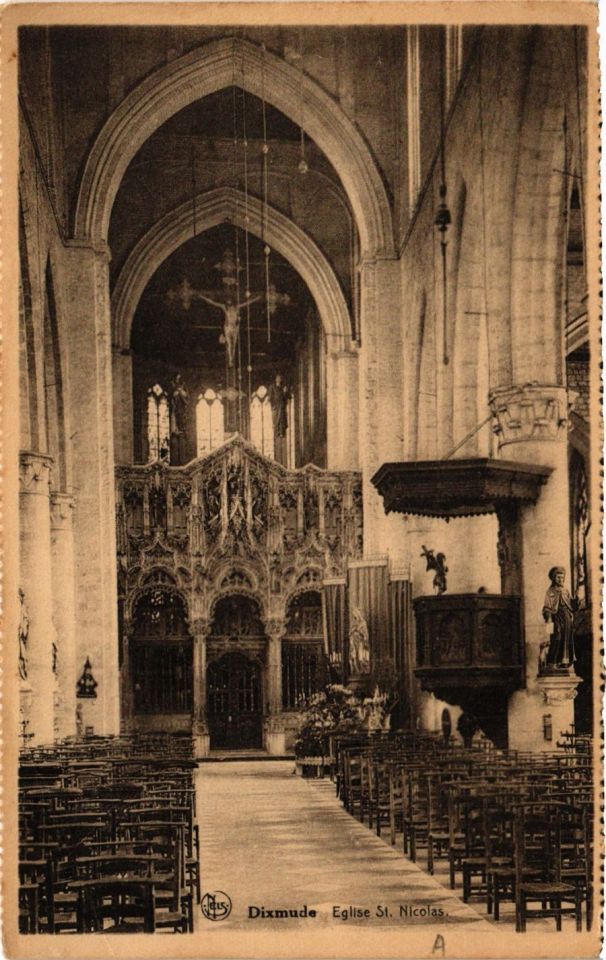
Interior of the St. Nicolas Church in Dixmude, Flemish region of Belgium
Belgian vintage postcard
#church#historic#belgian#belgium#photo#briefkaart#vintage#region#flemish#sepia#photography#the st. nicolas church#carte postale#postcard#postkarte#nicolas#postal#tarjeta#ansichtskarte#old#st#ephemera#postkaart#dixmude#interior
5 notes
·
View notes
Text
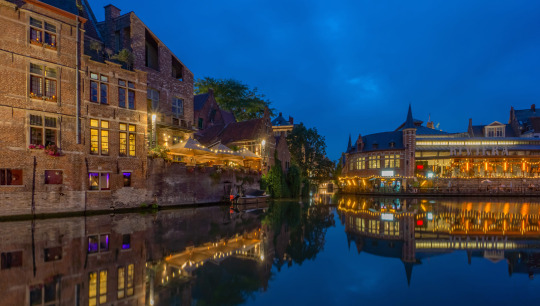
GENT, Flemish region, Belgium 🇧🇪 by Robert Karo on 500px
#gent#gant#belgium#gent belgium#gant belgium#flemish region belgium#belgium europe#gent europe#gant europe#gent belgium europe#gant belgium europe
17 notes
·
View notes
Text
It's Sweet Potato Awareness Month!


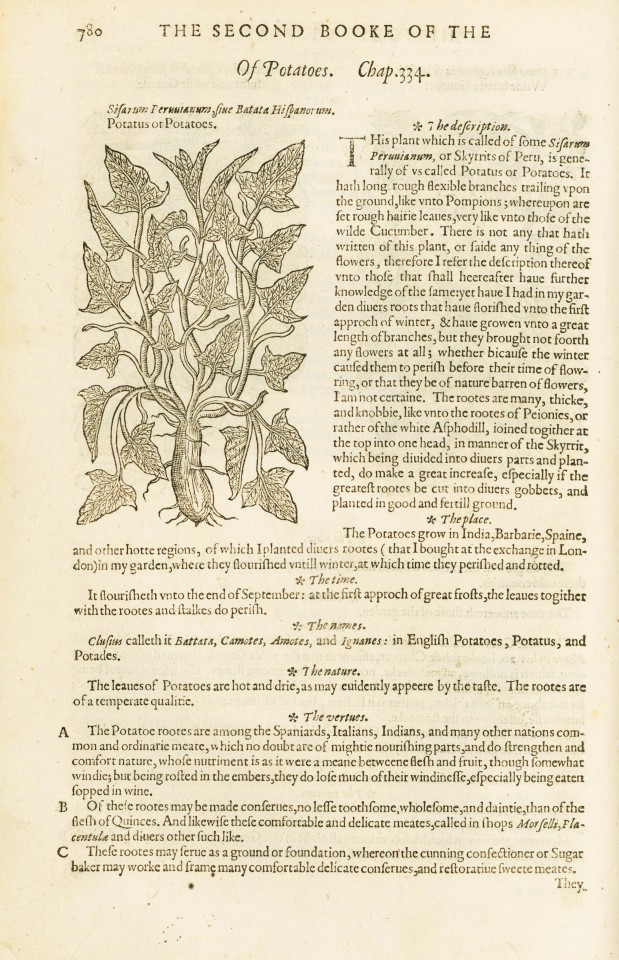
November is here and with it, Sweet Potato Awareness Month!
Native to tropical regions of the Americas and domesticated at least 5,000 years ago, the sweet potato is a delightful member of the morning glory family. Not to be confused with yams, sweet potatoes produce long vines with heart-shaped leaves and flowers above ground and delicious starchy tubers sprawling beneath the dirt. It is said that Columbus and his crew were the first Europeans to encounter and taste sweet potatoes, and they have been a staple among the American diet ever since with the average per capita consumption around 4.4 pounds per year.
In recognition of Sweet Potato Awareness Month, we’re looking at John Gerard’s Herball, or Generall Historie of Plantes. The book is his translation of a Latin version that was originally published in Flemish and includes some of Gerard’s original assertions and annotations from his own garden. Published in 1597 by the Queen's printer John Norton, it notably includes an example of the first English description of the potato! What Gerard describes as potatus or potatoes are in fact what we know today as sweet potatoes. Gerard’s lack of scientific knowledge led to misunderstandings about the plants he wrote about and criticism from his contemporaries. See our Science Saturday post for all the hot gossip about Gerard’s incompetencies and accusations of plagiarism.
Despite the drama surrounding Gerard’s botanical authorship and because of the inclusion of over 1,000 plants including illustrations, habits, and uses, Herball was an exhaustive and highly used resource of its time.
View other posts with our copy of Gerard's Herball.
-Jenna, Special Collections Graduate Intern
#sweet potato awareness month#john gerard#herball or generall historie of plantes#sweet potatoes#holiday post#gerard's herball#john norton#botany#holidays
104 notes
·
View notes
Text
I'm starting to read articles for my bachelor's thesis and did you know werewolves as folklore are actually mostly recorded in NRW and the Dutch-Flemish border regions? Also, (European) werewolves had no connection to the moon or to it being an illness/ condition before the rise of movie monsters. It's not even proven people saw werewolves as actual transformed beasts but just humans in disguise (usually at will).
37 notes
·
View notes
Text
THIS DAY IN GAY HISTORY
based on: The White Crane Institute's 'Gay Wisdom', Gay Birthdays, Gay For Today, Famous GLBT, glbt-Gay Encylopedia, Today in Gay History, Wikipedia, and more … February 13



518 B.C. – Pindar, the Greek poet was born today. Again, it is impossible to say precisely when the Theban poet was born, so we're picked this arbitrary date. So this is as good a place as any to mention Pindar, the greatest lyric poet of ancient Greece, whose love for Theoxenus of Tenedos is celebrated in his verse.


Self-portrait
1891 – Grant Wood (d.1942) was an American painter born four miles east of Anamosa, Iowa. He is best known for his paintings depicting the rural American Midwest, particularly the painting American Gothic, an iconic image of the 20th century.
After graduating from Washington High School, Wood enrolled in an art school in Minneapolis in 1910, and returned a year later to teach in a one-room schoolhouse. In 1913 he enrolled at the School of the Art Institute of Chicago and performed some work as a silversmith. From 1920 to 1928, he made four trips to Europe, where he studied many styles of painting, especially Impressionism and Post-Impressionism. But it was the work of the 15th-century Flemish artist Jan van Eyck that influenced him to take on the clarity of this new technique and to incorporate it in his new works.
From 1924 to 1935, Wood lived in the loft of a carriage house that he turned into his personal studio at "5 Turner Alley" (the studio had no address until Wood made one up himself). In 1932, Wood helped found the Stone City Art Colony near his hometown to help artists get through the Great Depression. He became a great proponent of regionalism in the arts, lecturing throughout the country on the topic. Wood taught painting at the University of Iowa's School of Art from 1934 to 1941. During that time, he supervised mural painting projects, mentored students, produced a variety of his own works, and became a key part of the University's cultural community.
One common theory is that he was a closeted homosexual, and was fired from the University because of a relationship with his personal secretary.
On February 12, 1942, one day before his 51st birthday, Wood died at the university hospital of pancreatic cancer. When Wood died, his estate went to his sister, Nan Wood Graham, the woman portrayed in American Gothic.

Wood's best known work, his 1930 painting American Gothic, is also one of the most famous paintings in American art, and one of the few images to reach the status of universally recognised cultural icon, comparable to Leonardo da Vinci's Mona Lisa and Edvard Munch's The Scream.
It was first exhibited in 1930 at the Art Institute of Chicago, where it is still located. It was given a $300 prize and made news stories country-wide, bringing Wood immediate recognition. Since then, it has been borrowed and satirised endlessly for advertisements and cartoons.


Wheeler and Wescott by Lynes
1899 – on this date the American curator Monroe Wheeler, was born (d.1988). Poet and author Glenway Wescott and Monroe Wheeler were an extraordinary couple. The two met for the first time in 1919, and it was, it seems, a classic case of love at first sight. At the time, Wescott was still in his teens and Wheeler just 20. Seemingly inured to the social mores of the time and inconstancies of youth, the two embarked on a relationship that can be called nothing short of a marriage, for the next 68 years, until Wescott's death in 1987. They are perfect gay Valentine icons.
The young couple travelled the world, stopping in on Gertrude Stein's Paris Salon and crossing paths with Jean Cocteau on the Riviera, while Wescott developed his poetry and later fiction (he authored The Grandmothers and The Pilgrim Hawk, among other bestsellers of his day) and Wheeler found his path. Eventually he would become the director of exhibitions and publications at the Museum of Modern Art.
The two moved with equal ease through the literary and artistic circles of London and the continent as well as their families' Midwestern homes. That their relationship thrived is notable enough. But 1927 brought a new challenge to their pairing. High-school student George Platt Lynes fell passionately in love with the strikingly good-looking Wheeler. And Wheeler, for his part, was entranced by Lyne's 'full, luscious mouth and his wasp-like waist'. Instead of driving a wedge between Wescott and Wheeler, as might be expected, Lynes soon became part of their shared life. When, after some casting about, he hit upon photography, the two nurtured his career and used their considerable connections to get him both work and gallery shows.

Triptych of Wescott-Lynes-Wheeler by Jared French
In 1930, while still in France, Wheeler entered into a partnership with Barbara Harrison to establish the Harrison of Paris press, the goal of which was to publish fine editions of new and neglected classics. Over 5 years, they produced 13 titles, including works by Thomas Mann, Katherine Anne Porter, and Glenway Wescott's A Calendar of Saints for Unbelievers, with illustrations by Pavel Tchelitchew.
In 1935, following the marriage of Barbara Harrison to Glenway's younger brother, Lloyd, Wheeler and Wescott moved back to the United States. They soon set up households both on the farm in New Jersey bought by Barbara Harrison and Lloyd Wescott and in New York City, where they shared a series of apartments with George Platt Lynes.
It was at this time that Wheeler began an association with the Museum of Modern Art when, in 1935, he guest-curated an exhibit. His position at MOMA became permanent in 1938 when he was hired as Membership Director, then moved quickly into the position of Director of Exhibitions and Publications. Wheeler's innovations in publication and exhibit design soon became well-known. In 1951, in recognition of his work in bringing French artists to the attention of American viewers, he was made a Chevalier of the French Legion of Honor by the government of France.
In 1967, in preparation for his retirement, Wheeler shifted his duties at the museum. Having long been a trustee of the museum, he was appointed counsellor and joined the International Council in its biannual meetings. After his official retirement in 1967, he continued to advise the museum on exhibitions and serve with a number of civic and arts organizations.
In 1969, Wheeler travelled as a cultural advisor with Nelson Rockefeller on a presidential mission to Latin America. In the 1970s, Wheeler travelled extensively and worked on projects documenting the history of MOMA and the collections of the Rockefeller family. Monroe Wheeler died in Manhattan on August 14th 1988 at the age of 89, 18 months after the death of Glenway Wescott.


1961 – Henry Rollins is an American spoken word artist, writer, journalist, comedian, publisher, actor, radio DJ, activist and musician.
After performing for the short-lived Washington D.C.-based band State of Alert in 1980, Rollins fronted the California hardcore punk band Black Flag from August 1981 until mid-1986. Following the band's breakup, Rollins established the record label and publishing company 2.13.61 to release his spoken word albums, as well as forming the Rollins Band, which toured with a number of lineups from 1987 until 2003, and during 2006.
Since Black Flag disbanded, Rollins has hosted numerous radio shows, such as Harmony in My Head on Indie 103, and television shows such as The Henry Rollins Show, MTV's 120 Minutes, and Jackass.
He had a recurring dramatic role in the second season of Sons of Anarchy and has also had roles in several films. Rollins has also campaigned for various political causes in the United States, including promoting LGBT rights, World Hunger Relief, and an end to war in particular, and tours overseas with the United Service Organizations to entertain American troops.
Rollins has become an outspoken human rights activist, most vocally for gay rights. Rollins frequently speaks out on social justice on his spoken word tours and promotes equality, regardless of sexuality. He was the host of the WedRock benefit concert, which raised money for a pro-gay-marriage organization.
He has said of his sexuality:
"If I was gay, there would be no closet, you would never see the closet I came out of. Why? I would have burned it for kindling by the time I was 12. Because I know with all certainty in my mind, there is nothing wrong with being gay, and you know it."


1969 – Joe Phillips is a black American artist, known for his mainstream comic book art and for his work depicting his views of gay life. Ironically, he is most recognized for portraying white, preppy males. He currently lives in San Diego, California.
Phillips was born in Atlanta, Georgia in 1969. Upon graduation he travelled to Europe where he furthered his artistic skills, taking part in various projects such as guerrilla street art.
His first major comic book job was working on the comic book "Speed Racer" for seven issues. He produced artwork for titles including "Justice League of America", "Silver Surfer", "X-Men", "Legion of Super-Heroes", "The Incredible Hulk" and "Lobo".
Phillips was one of the founding members of Gai-Jin Studios. In late 1992 he began work on the revival of "Timber Wolf," written and inked by Al Gordon, where he worked as both a penciller and as the cover artist, this run lasted for an entire story arc. In 1996 he created a new comic book character, "The Heretic", of which he was both a writer and artist. The title was released by Dark Horse Comics. Other later work included "Captain America", "Wolverine", "Green Lantern" and "Superboy".
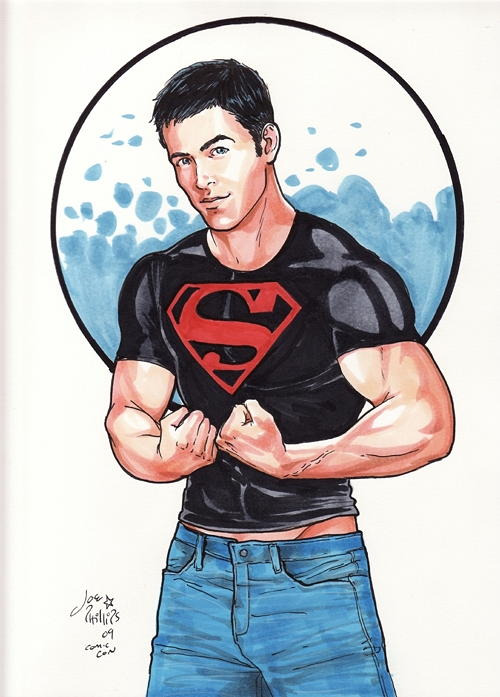
Sexy Superboy
It was while Phillips was working on a Superboy comic entitled "Superboy & Risk: Double Shot" that he first sexualized his artwork and dropped hints about homosexuality. Some readers picked up on this, one such person was art director of XY Magazine, Eriq Chang. Chang quickly offered Phillips a slot in the gay publication drawing a comic strip that would later become known as "Joe Boy".
Phillips was approached by the hardcore porn website Karas Adult Playground to produce adult animation, his first - Cumquest - was a spoof on the popular sci-fi series Star Trek. Another animation job followed for the gay porn website Absolutely Male for which Phillips created the animation The House of Morecock, a story about Jonas Morecock, a gay paranormal investigator. Morecock proved to be very popular and a set of 10 episodes was released on DVD by 10% Productions in 2001. In 2002 Morecock was nominated for a GayVN award in the category "Best Alternative Release"; it subsequently won in its category. A series of comic strip books followed alongside sets of postcard books. TLA Video lists Morecock as one of their all-time bestselling titles.

'A Boys Will Be Boys" illustration
In 2001 Phillips released "Boys Will Be Boys" - a calendar featuring original gay-themed art. In 2003 a book of the same title was released; it featured the art from the 2002 and 2003 calendars and incorporated some new original pieces. The calendar continues to be released annually.
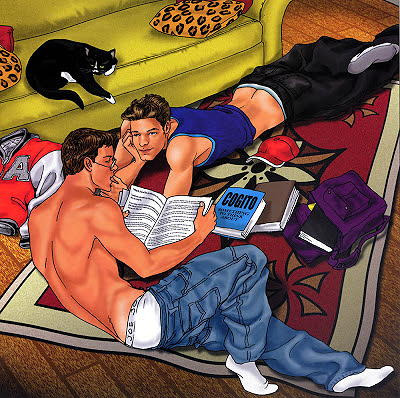
another typical "Boys Will Be Boys" illustration
In 2006 with Adult Visual Animation, Phillips released his second adult-themed animated movie entitled Stonewall & Riot: The Ultimate Orgasm. The movie was a cross-over of the two genres Phillips was known for - Superheroes and work for the gay community. The movie was created entirely in 3D graphics. As with his previous movie, "Stonewall & Riot" was nominated for a GayVN award.
In 2013, Phillips animated and directed the official music video for UK Rock singer/songwriter Matt Fishel's single "When Boy Meets Boy". Described by Out Magazine as a "cute (and sexy)" love story "with a superhero twist", it shows an animated version of Fishel meeting a mysterious skater boy in a bar and concludes with a superhero fight and rescue sequence. British magazine The Gay UK called it "one of the best music videos we've seen in a long time." On 30 October 2013, the video for "When Boy Meets Boy" won the 2013 RightOutTV Music & Video Award for Best Pop/Rock Video. Phillips also created all the artwork for Matt Fishel's debut album Not Thinking Straight, which was released in April 2013 on Young Lust Records. The album booklet comprises 18 original illustrations by Phillips, each representing a different song's lyrics and portraying themes and issues surrounding young gay life, relationships and experiences. Phillips also created the artwork for Matt Fishel's 2013 singles "Radio-Friendly Pop Song", "When Boy Meets Boy" and "Oh Santa!"
Below: When Boy Meets Boy (3 mins 47 sec)
youtube


1987 – Steven Dehler is an American model, actor, and dancer. He has been described as the "the poster child for the modern male underwear model". He is a regular performer at The Abbey, a gay bar and nightclub in West Hollywood, California, and has been face of Marcuse Swimwear for their 2015 campaign.
With an active social media presence, Dehler has amassed over 142,000 followers on Instagram as of November 2015. Also in 2015, Dehler made the cover of Odyssey Magazine and played Mr. Coconuts on the Ellen Degeneres Show.
Steven Edward Dehler was born in Simi Valley. He is one of two children, with an older brother. While in elementary school, Dehler was the victim of bullying, where they would call him "Steven Gayler".
Dehler began his career working in West Hollywood. Originally he was a server in a small bar, then moved to doing bottle service at a club called Eleven. After winning a hot body contest at another club in West Hollywood, he was asked by a go-go dancer bookers saw Dehler and asked him to dance. After dancing at many locations around the area, by 2012 Dehler was dancing exclusively for The Abbey.
Dehler began his modeling career with Timoteo, an underwear and swimwear line. Along with Timoteo, he has also modeled for Marcuse, Freedom Reigns, and Marco Marco Underwear. Most prominently, Dehler has modeled for male underwear company Andrew Christian. One of the shoots he did involved a commercial called Freshman Car Wash, which also offered an unrated version online. Another was "Lick", which was shot with then-boyfriend (and fellow model) Montana Volby.
Well-known in the West Hollywood gay scene, Dehler is sometimes the subject of gossip columns

2009 – on the campus of Cornell University, a group of roughly 20 students lined up to hold a colorful banner that read "QUEER KISSIN' ... in progress" and then proceeded have a queer kiss-in. Direct Action to Stop Heterosexism sponsored the event, according to kiss-in participant Ashley McGovern. She explained that heterosexism is "kind of like homophobia except heterosexism has to do with all facets of society."
DASH didn't necessarily have sweeping or profound aims for the kiss-in, according to McGovern. "It was just supposed to be a fun action before Valentine's Day, it wasn't really a protest, it was more of a visibility thing ... just letting people know people are queer on campus and not afraid to be affectionate ... that was the goal — visibility and having fun," McGovern said.
Meanwhile at the University of Colorado in Boulder, Colorado, the Dalton Trumbo Fountain outside the University Memorial Center was the site of a mass make-out session titled "Make Out Stake Out." The "flash mob" of student couples of varying sexual orientations suddenly appeared at the fountain square, made out for two minutes — and then dispersed. "We're trying to remove the stigma that surrounds same-sex affection in public and, more importantly, the misconception that if you are queer and you are expressing affection in public that you are rubbing it in people's faces," junior Spencer Watson said.


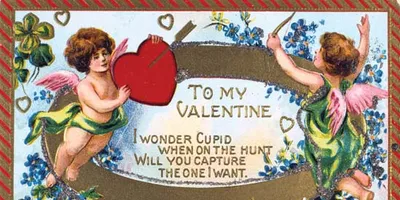
26 notes
·
View notes
Text
ok ok Belgianposting on main because this is so fucking funny I was reading about the separatist movement(s) in Wallonia, and their standard goal is to merge French speaking Belgium with France right, checks out, mirroring the Flemish separatists wanting to join The Netherlands.
But! Apparently there are Wallonian separatists who who leave out the separation part and just want to chuck THE ENTIRETY OF BELGIUM into France, Flanders and all, and I can’t stop laughing at that mental image.
Imagine having a region in France that speaks Dutch now. Imagine the disgust on the faces of French people if someone walked up and went “Hallo iedereen, ik ben een Fransman nu, ik kom kamperen en deze keer is het PERMANENT” They would kill every last one of us.
590 notes
·
View notes
Text

L E U V E N
107 notes
·
View notes
Text
In 1678, a Chaldean priest from Baghdad reached the Imperial Villa of Potosí, the world’s richest silver-mining camp and at the time the world’s highest city at more than 4,000 metres (13,100 feet) above sea level. A regional capital in the heart of the Bolivian Andes, Potosí remains – more than three and a half centuries later – a mining city today. [...] The great red Cerro Rico or ‘Rich Hill’ towered over the city of Potosí. It had been mined since 1545 [...]. When Don Elias arrived [...], the great boom of 1575-1635 – when Potosí alone produced nearly half the world’s silver – was over, but the mines were still yielding the precious metal. [...]
On Potosí’s main market plaza, indigenous and African women served up maize beer, hot soup and yerba mate. Shops displayed the world’s finest silk and linen fabrics, Chinese porcelain, Venetian glassware, Russian leather goods, Japanese lacquerware, Flemish paintings and bestselling books in a dozen languages. [...]
Pious or otherwise, wealthy women clicked Potosí’s cobbled streets in silver-heeled platform shoes, their gold earrings, chokers and bracelets studded with Indian diamonds and Burmese rubies. Colombian emeralds and Caribbean pearls were almost too common. Peninsular Spanish ‘foodies’ could savour imported almonds, capers, olives, arborio rice, saffron, and sweet and dry Castilian wines. Black pepper arrived from Sumatra and southwest India, cinnamon from Sri Lanka, cloves from Maluku and nutmeg from the Banda Islands. Jamaica provided allspice. Overloaded galleons spent months transporting these luxuries across the Pacific, Indian and Atlantic oceans. Plodding mule and llama trains carried them up to the lofty Imperial Villa.
---
Potosi supplied the world with silver, the lifeblood of trade and sinews of war [...]. In turn, the city consumed the world’s top commodities and manufactures. [...] The city’s dozen-plus notaries worked non-stop inventorying silver bars and sacks of pesos [...]. Mule trains returning from the Pacific brought merchandise and mercury, the essential ingredient for silver refining. [...] From Buenos Aires came slavers with captive Africans from Congo and Angola, transshipped via Rio de Janeiro. Many of the enslaved were children branded with marks mirroring those, including the royal crown, inscribed on silver bars.
Soon after its 1545 discovery, Potosí gained world renown [...]. Mexico’s many mining camps [...] peaked only after 1690. [...] Even in the Andes of South America there were other silver cities [...]. But no silver deposit in the world matched the Cerro Rico, and no other mining-refining conglomeration grew so large. Potosí was unique: a mining metropolis.
Thus Don Elias, like others, made the pilgrimage to the silver mountain. It was a divine prodigy, a hierophany. In 1580, Ottoman artists depicted Potosí as a slice of earthly paradise, the Cerro Rico lush and green, the city surrounded by crenellated walls. Potos��, as Don Quixote proclaimed, was the stuff of dreams. Another alms seeker, in 1600, declared the Cerro Rico the Eighth Wonder of the World. A [...] visitor in 1615 gushed: ‘Thanks to its mines, Castile is Castile, Rome is Rome, the pope is the pope, and the king is monarch of the world.’ [...]
---
For all its glory, Potosí was also the stuff of nightmares [...].
Almost a century before Don Elias visited Potosí, Viceroy Francisco de Toledo revolutionised world silver production. Toledo was a hard-driving bureaucrat of the Spanish empire [...]. Toledo reached Potosí in 1572, anxious to flip it into the empire’s motor of commerce and war. By 1575, the viceroy had organised a sweeping labour draft, launched a ‘high-tech’ mill-building campaign, and overseen construction of a web of dams and canals to supply the Imperial Villa with year-round hydraulic power, all in the high Andes at the nadir of the Little Ice Age. Toledo also oversaw construction of the Potosí mint, staffed full-time with enslaved Africans. [...] Toledo’s successes came with a steep price. Thanks to the viceroy’s ‘reforms’, hundreds of thousands of Andeans became virtual refugees (those who survived) and, in the search for timber and fuel, colonists denuded hundreds of miles of fragile, high-altitude land. [...] The city’s smelteries belched lead and zinc-rich smoke [...].
The Habsburg kings of Spain cared little about Potosí’s social and environmental horrors. [...] For more than a century, the Cerro Rico fuelled the world’s first global military-industrial complex, granting Spain the means to prosecute decades-long wars on a dozen fronts – on land and at sea. No one else could do all this and still afford to lose. [...]
By [...] 1909 [...], mineral rushes had helped to produce cities such as San Francisco and Johannesburg, but nothing quite compared for sheer audacity with the Imperial Villa of Potosí, a neo-medieval mining metropolis perched in the Andes of South America.
---
Text by: Kris Lane. “Potosi: the mountain of silver that was the first global city.” Aeon. 30 July 2019. [Bold emphasis and some paragraph breaks/contractions added by me.]
80 notes
·
View notes
Text
Deep dives into folklore: Belgian folklore
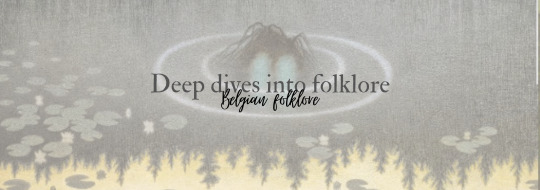
Belgium, nestled in the heart of Europe, boasts a cultural landscape steeped in folklore and mythology that has thrived across centuries. This exploration delves into the captivating narratives and enduring traditions that have shaped Belgian folklore, illuminating the cultural tapestry of this diverse and enchanting region.
Belgian folklore is adorned with a diverse array of mythical creatures, each adding its own hue to the cultural canvas. From the water-dwelling Nixen to the forest-dwelling Wild Huntsman, these fantastical beings embody the collective imagination of the Belgian people, woven into the fabric of their storytelling traditions.
In the southern Walloon region, folklore weaves tales of the Géants, colossal figures parading through festivals, representing both mythical and historical elements. The Géants embody a living mythology, embodying the resilience and spirit of the communities they traverse, leaving an indelible mark on the cultural identity of the Walloons.
Flemish folklore is colored by traditions that celebrate the cyclical nature of life, from the lively Kattenstoet (Cat Parade) in Ypres to the whimsical Carnaval de Binche. Amidst these festivities, the figure of the 'Huisgod,' or house spirit, stands as a guardian and symbol of domestic harmony, reflecting the importance of familial ties in Flemish culture.
Belgium's folklore is haunted by spectral entities, such as the Kludde and Lange Wapper, whose eerie tales resonate across generations. These ghostly apparitions, born from the depths of Belgian imagination, serve as cautionary figures, embodying the moral compass of a society navigating the boundaries between right and wrong.
Belgium's rich history has given rise to mythic tales surrounding ancient landmarks, such as the dolmens of the Ardennes. These megalithic structures, wrapped in the cloak of legend, connect the present to the distant past, symbolizing the enduring legacy of Belgian folklore in shaping perceptions of the land itself.
While rooted in tradition, Belgian folklore continues to adapt, finding new expression in contemporary culture. From literature to cinema, modern storytellers draw inspiration from ancient myths, breathing new life into the timeless narratives that have defined the Belgian cultural narrative.
In the realm of Belgian folklore and mythology, the tales, creatures, and traditions form an intricate web, binding communities and generations together. The colorful threads of these narratives, woven into the cultural fabric, transcend time, offering a glimpse into the collective imagination of a nation that cherishes its mythical past while embracing the ever-evolving stories that shape its cultural identity. The richness of Belgian folklore stands as a testament to the enduring power of storytelling, echoing through the ages and resonating in the hearts of those who continue to unravel its captivating threads.
#writeblr#writers of tumblr#writing#bookish#booklr#fantasy books#creative writing#book blog#ya fantasy books#ya books#writers block#national novel writing month#writers#teen writer#tumblr writers#writer problems#writblr#writerblr#writers community#writers corner#writerscommunity#writers on tumblr#writerslife#writing blog#writing community#writers and poets#deep dives into folklore#deep dives#folklore#myths
12 notes
·
View notes
Text
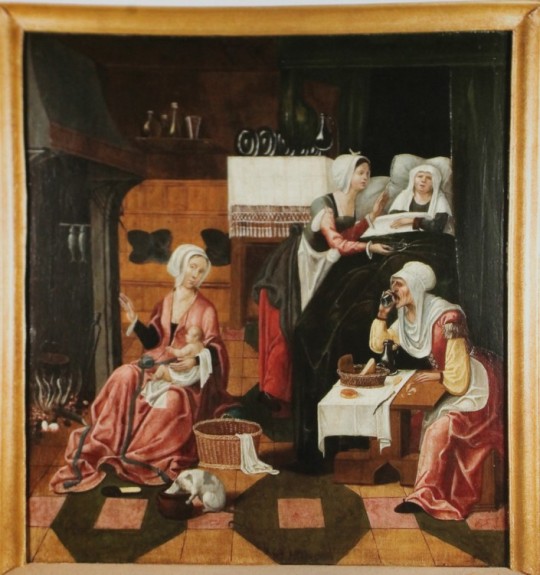
Adriaen van Overbeke - Birth of the Virgin - Petrikirche altarpiece -
Adriaen van Overbeke, Adrian van Overbeck and Adriaen van Overbeke (fl 1508 – 1529) was a Flemish Renaissance painter in the style of Antwerp Mannerism. He operated a large workshop with an important output of altarpieces, which were mainly exported to Northern France, the Rhineland and Westphalia. His known works were predominantly polychromed wooden altarpieces with painted shutters, which were created through a collaboration between painters and sculptors.
Dutch and Flemish Renaissance painting represents the 16th-century response to Italian Renaissance art in the Low Countries, as well as many continuities with the preceding Early Netherlandish painting. The period spans from the Antwerp Mannerists and Hieronymus Bosch at the start of the 16th century to the late Northern Mannerists such as Hendrik Goltzius and Joachim Wtewael at the end. Artists drew on both the recent innovations of Italian painting and the local traditions of the Early Netherlandish artists.
Antwerp was the most important artistic centre in the region. Many artists worked for European courts, including Bosch, whose fantastic painted images left a long legacy. Jan Mabuse, Maarten van Heemskerck and Frans Floris were all instrumental in adopting Italian models and incorporating them into their own artistic language. Pieter Brueghel the Elder, with Bosch the only artist from the period to remain widely familiar, may seem atypical, but in fact his many innovations drew on the fertile artistic scene in Antwerp.
Dutch and Flemish painters were also instrumental in establishing new subjects such as landscape painting and genre painting. Joachim Patinir, for example, played an important role in developing landscape painting, inventing the compositional type of the world landscape, which was perfected by Pieter Bruegel the Elder who, followed by Pieter Aertsen, also helped popularise genre painting. From the mid-century Pieter Aertsen, later followed by his nephew Joachim Beuckelaer, established a type of "monumental still life" featuring large spreads of food with genre figures, and in the background small religious of moral scenes. Like the world landscapes, these represented a typically "Mannerist inversion" of the normal decorum of the hierarchy of genres, giving the "lower" subject matter more space than the "higher". Anthonis Mor was the leading portraitist of the mid-century, in demand in courts all over Europe for his reliable portraits in a style that combined Netherlandish precision with the lessons of Titian and other Italian painters.
10 notes
·
View notes
Photo

Oude Rode Ogen [Flemish/Belgian folktales]
When it comes to Belgian folktales, ‘Oude Rode Ogen’ is in a bit of a weird position. The story is common on online blogs about folklore or mythology, usually hailed as one of the most well-known Belgian monsters. But if you actually try to find Belgian sources or ask Belgian experts, you’ll find that the story is virtually unknown there, only being mentioned by a handful of authors. Therefore, I suspect that this was a very niche tale that only recently gained traction via the internet.
The name ‘Oude Rode Ogen’ literally translates to ‘Old Red Eyes’ which is fitting because the monster is a giant black dog with brightly burning red eyes. He can transform into a very tall man, about 2m10 (6’ 11”). According to art historian Hilde van Gelder, tales of this creature were told in Mechelen (Flanders) in the late 17th century. In these folktales, Oude Rode Ogen is a swamp-dwelling monster that takes children who venture too close to the marshlands. It hunts at night and sometimes attacks adults as well. Oude Rode Ogen is a bogeyman, meaning this story was told to dissuade children from playing near potentially dangerous places (and from staying up late, for the monster was said to eat kids who are awake at night). Vincent Menten, author of ‘The Beast of Flanders’, additionally claimed that the creature had the power to take away the ability to hear, see and talk of anyone who looks directly at it, leaving its victims mute, blind and deaf.
This creature was also known in Wallonia (the southern part of the country) where it was called “Le Tchén al Tchinne” which is a regional dialect for “Le Chien à la Chaîne” which translates to “the dog on a chain”. Hence, the monster supposedly dragged a heavy metal chain behind it.
The story claims that after several children had inexplicably gone missing in the region, locals began to suspect that these disappearances were connected. Rumors began to arise that the kids were taken by a werewolf. Eventually, a tall man was caught in an attempt to kidnap a young girl. He was naked and tried to run away when his attempt was foiled, but got shot. Instead of dying, however, the man transformed into a large black dog, which quickly fled the scene. With no other option, the people of Mechelen combed the city for suspicious individuals and found a poor homeless man. Though his connection to the city’s unnatural enemy could not be proven, he was found guilty and executed. To make sure the monster wouldn’t come back, the body was skinned entirely and the skin was buried underneath the local cathedral.
But the vengeful spirit of the creature continued to roam the area at night, in the form of a large black dog with glowing red eyes. Oude Rode Ogen is searching for his skin, so he can put it on and be reborn again.
This monster is thought to be related to (or to be the same creature entirely) as the Nekker, a Flemish aquatic bogeyman that attacked people who ventured too close to wells and rivers. Its name is derived from an old Germanic verb meaning ‘to wash’, referring to the aquatic nature of the monsters. Though the name ‘Oude Rode Ogen’ is very rarely mentioned in offline sources, myths and folktales of Nekkers are well documented.
Sources:
De Lavigne, G., 2015, Les Chiens Célèbres, Réels et Fictifs, dans l’art, la culture et l’histoire, Lulu, 572 pp.
Van Gelder, H., 2015, Contour 7, Fooling Utopia, Leuven University.
(image source: Emryswolf on Deviantart. This image depicts a generic evil black dog, as they are common characters in world mythology)
120 notes
·
View notes